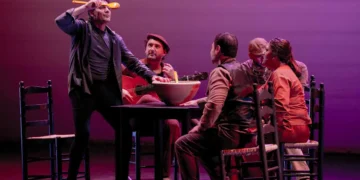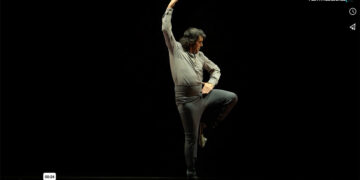 16th Festival de Jerez 2012 16th Festival de Jerez 2012
Joaquín Grilo “La Mar de Flamenco”
|
|
Text: Estela Zatania A BIRD’S-EYE TAKE ON FLAMENCO Dance: Joaquín Grilo, Javier Pérez. Guitar: Juan Requena. Cante: José Valencia, Carmen Grilo. Neyzen and baglama: Bilgin Canaz. Harmonica and keyboard: Antonio Serrano. Artistic and choreographic director: Joaquín Grilo. I’m convinced the worst thing you can do with a genius is give him or her a free rein. Geniuses are brave people who have no interest in the established order of things, need to express themselves with complete freedom and have endless fragments of ideas in their heads. Two main elements defined the work that Jerez dancer and genius called Joaquín Grilo put on the stage of the Villamarta Theater to close this important festival. The last scene, “Del Morao al Cielo”, was a beautiful and well-conceived tribute to Moraíto, the beloved maestro of the guitar who suddenly left us seven months ago, leaving a deep wound in all of us who heard him play or knew him personally. Grilo had shared countless shows and tours with Moraíto, and an especially brilliant highlight of their collaboration was the instrumental bulería for which the dancer mounted a particularly apt choreography (it’s not every day you see a choreographed bulería, and without singing) that no other dancer would be capable of interpreting, partly because of the high technical level, and partly because of Grilo’s unique and highly stylized way of dancing For this “experience”, because it went beyond a simple number to end the show, Marcos Serna, who was in charge of the lighting, found a way to convert the stage of the Villamarta into a starry sky with hundreds of pinpoints of light, and the rest of the theater became inundated with a mysterious blue luminosity that resembled a clear nighttime sky with full moon. From the rear of the audience, Grilo, who almost seemed to be emitting light of his own with a gleaming white suit, came down the aisle with obvious angst to reach the stage where guitarist Juan Requena (again noteworthy in this festival) played Moraíto’s composition for Joaquín’s dance. When the image of Moraíto became visible among the stars like a great flamenco constellation, kitschy though it may sound, believe me, no one could help but be moved. In a way, the rest of the show was little more than a filler for that unforgettable moment. Because “forgettable” is the most accurate adjective to describe the rest. Lots of confused symbolism, many tedious silences, a jacket with very long fringe, finger cymbals and…ankle bells?…(the dancer put them on, but they never sounded), the histrionic operatic delivery of Carmen Grilo, a José Valencia who does what he can, which is a lot, but who is not permitted to do much at all… And then there’s the bird. The big bird. A modern dancer (Javier Pérez), impersonating a large bird that might have more or less been acceptable in a brief scene, tried the audience’s patience to the limit with a long segment, then returning again later on and triggering a barely audible “ayyy” of discontent among the spectators who were anxious to see Grilo dance. In any other locale, the bird would have provoked cruel comments from the “peanut gallery”, but Joaquín Grilo is very well-loved in his hometown and the main reaction was stony silence. The harmonica of Antonio Serrano, used sparingly and wisely, was an element that gave a certain feeling of nostalgia related to the sea. The sound of a baglama, a Turkish string instrument, added an exotic air that blended in well. With a “mere” guajira, José Valencia managed to color everything with the flamenco we were all anxious to experience with the dancing of Grilo wearing a Cuban shirt and straw hat. The work’s marine motif wasn’t annoying, nor did it communicate much. There’s soleá, alegrías, there’s farruca, abandolao and taranta moments among other diverse fragments. But the annoying bird and the perfect jewel which is Moraíto’s bulerías with Grilo dancing, are the two most memorable moments, each in its own way, of “La Mar de Flamenco” that closed out the 2012 Festival de Jerez. Foreigners or newcomers are always convinced the most traditional flamenco tells an explicit story, and Joaquín Grilo and many others are quick to confirm and make good on that expectation. But dance critic Tobi Tobias once wrote that “no Western dance form exists that loathes having narratives thrust upon it more than flamenco”. We’ll leave that thought on the table as an epilogue to these sixteen days of coverage from the Festival de Jerez.
|
Descubre más desde Revista DeFlamenco.com
Suscríbete y recibe las últimas entradas en tu correo electrónico.



























